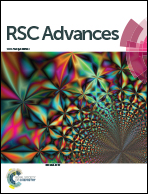Flexible thermo-electrochemical cells using Iodolyte HI-30 for conversion of low-grade heat to electrical energy
Abstract
In this research work, we investigated the flexible thermo-electro chemical cells (TECs) for the conversion of low-grade heat into electrical energy in the temperature range of 20–70 °C. The TECs were fabricated using 30 mM iodide/tri-iodide (Iodolyte HI-30) in acetonitrile as a redox couple. A TEC consists of a carbon/Iodolyte HI-30/carbon structure. The cell contains a flexible polymer tube, filled with the electrolyte, whereas the openings of the tube have been sealed using carbon electrodes. Gradients of temperature (ΔT) up to 50 °C have been created. The Seebeck voltages and short-circuit currents (Isc) were found to be 8–17 mV and 100–425 μA, respectively, in the 20–70 °C temperature range. It was found that the TECs could provide sufficient power to drive low-power electronic devices and could be used for measurement of temperature gradients as well. Furthermore, this work identifies the directions for realizing flexible thermo-electric cells that can be potentially used for several applications in the medical segment where, besides electrical and mechanical stability, flexibility is paramount.


 Please wait while we load your content...
Please wait while we load your content...